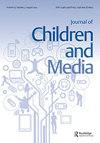Haptics and hotspots: creating usable and educational apps for children in the Netherlands
IF 2.1
3区 心理学
Q2 COMMUNICATION
引用次数: 2
Abstract
ABSTRACT This study investigated how app design features in educational apps affect app usability (i.e. effectiveness, efficiency, and satisfaction during use) and subsequent learning for Dutch children aged 4–5 years old. Guided by the Capacity Model 2.0 and Cognitive Load Theory, a 2 × 2 between-subjects experiment was conducted with 128 children (Mage = 4.73, SD = .40) to investigate how tactile (i.e. haptic movement: dragging versus tapping) and visual (i.e. hotspots: salient (moving) versus non-salient (non-moving) features in an educational app (M = 4.97 minutes game play) influence app usability and children’s learning – namely, receptive vocabulary acquisition. Results lent partial support to study hypotheses. Although children learned nearly five new Dutch words after playing the seeking game only once, the manipulated features did not explain this acquisition. In line with expectations, features did influence usability with salient hotspots proving to be a key predictor of usability. Implications are discussed. Impact Summary Prior State of Knowledge: Although there is much speculation regarding the impact of app design on the usability of and subsequent learning from children’s educational apps, empirical knowledge on this topic is lacking. Novel Contributions: This study is the first empirical investigation to combine predictions of the Capacity Model and Cognitive Load Theory to investigate how educational app design features (haptic and visual) predict app usability and subsequent learning for preschool-aged children. Practical Implications: For designers, results suggest that the thoughtful use of salient hotspots can lead to improved app usability. But, as demonstrated in the study, usability is not a guarantee for learning. It is crucial to consider how to use such features to support learning.触觉和热点:为荷兰的儿童创建可用的教育应用程序
摘要本研究调查了教育应用程序中的应用程序设计功能如何影响4-5岁荷兰儿童的应用程序可用性(即使用过程中的有效性、效率和满意度)和后续学习。以容量模型2.0和认知负荷理论为指导,对128名儿童(Mage=4.73,SD=0.40)进行了一项2×2的受试者间实验,以研究教育应用程序中的触觉(即触觉运动:拖动与敲击)和视觉(即热点:显著(移动)与非显著(非移动)特征(M=4.97分钟游戏)如何影响应用程序的可用性和儿童的学习——即,接受性词汇习得。研究结果为研究假设提供了部分支持。尽管孩子们只玩了一次寻找游戏就学会了近五个荷兰语新词,但被操纵的特征并不能解释这种习得。与预期一致,功能确实影响了可用性,突出的热点被证明是可用性的关键预测因素。讨论了影响。影响总结先前的知识状态:尽管有很多关于应用程序设计对儿童教育应用程序的可用性和后续学习的影响的猜测,但缺乏关于这一主题的实证知识。新颖贡献:这项研究是第一项将能力模型和认知负荷理论的预测相结合的实证研究,旨在研究教育应用程序设计特征(触觉和视觉)如何预测学龄前儿童的应用程序可用性和后续学习。实际意义:对于设计师来说,研究结果表明,深思熟虑地使用显著的热点可以提高应用程序的可用性。但是,正如研究所表明的那样,可用性并不能保证学习。考虑如何使用这些功能来支持学习是至关重要的。
本文章由计算机程序翻译,如有差异,请以英文原文为准。
求助全文
约1分钟内获得全文
求助全文

 求助内容:
求助内容: 应助结果提醒方式:
应助结果提醒方式:


